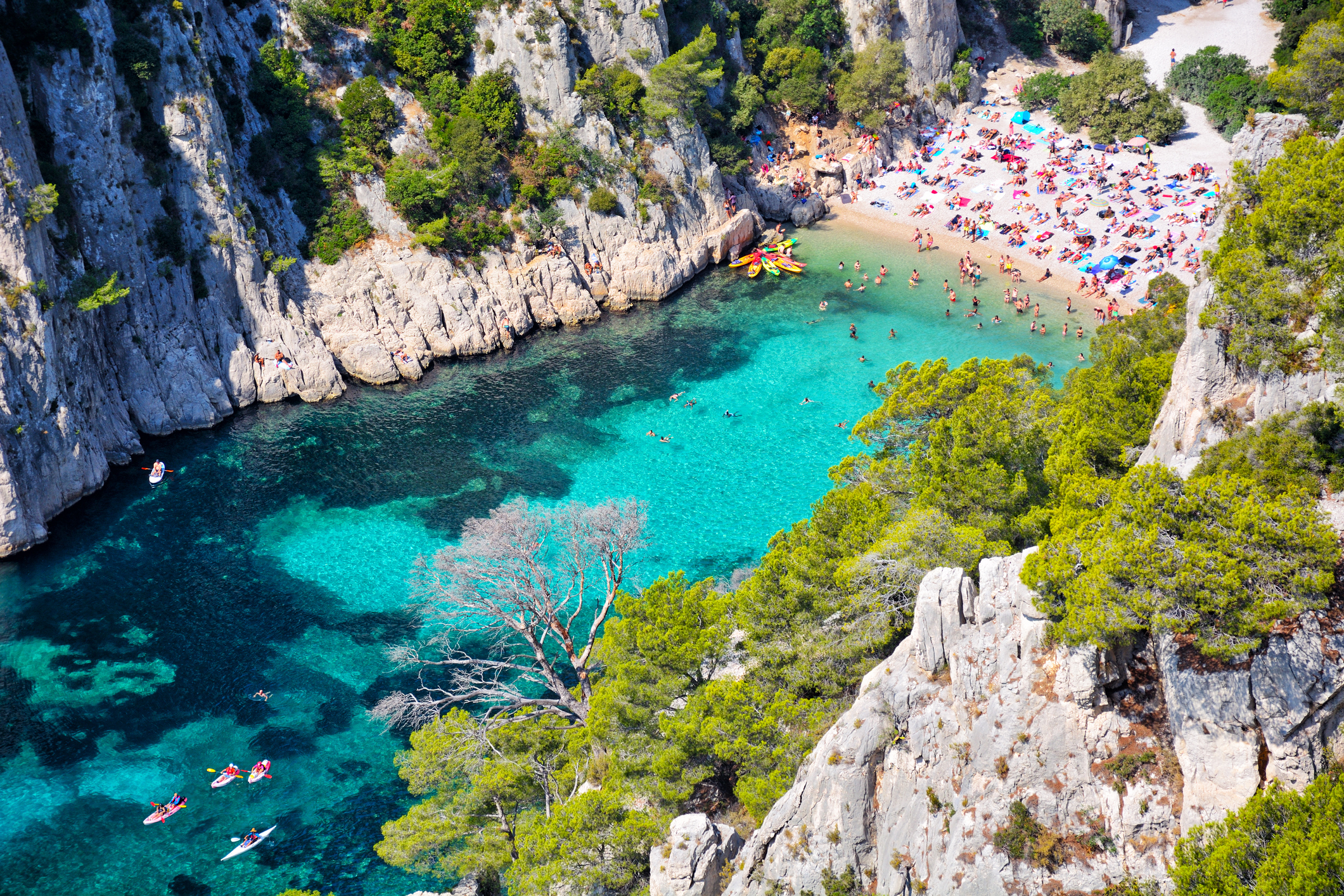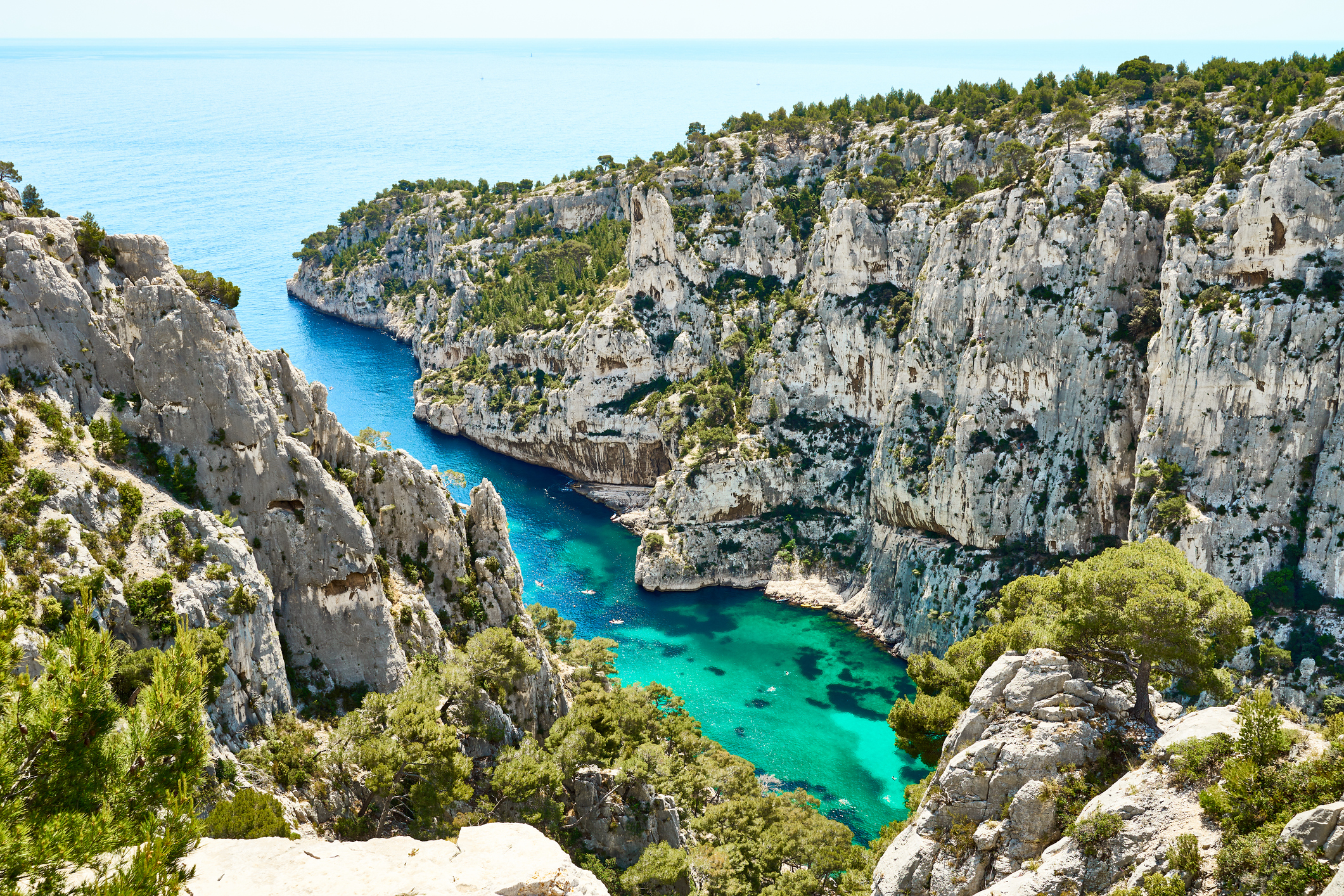When you think of the South of France, images of the tony resort towns of Cannes and Saint-Tropez probably pop into your mind. These places are known for buzzy beach clubs and harbors filled with million-dollar yachts.
There’s an alternative that is just as beautiful but slightly more down to earth.
Like Saint-Tropez, Cassis is a pastel-hued port town with adorable alleyways, but it still feels like a working fishing village. Fishermen sell the day’s catch at the port each morning, which sits in the shadow of a cliff-clinging castle. Rather than an international jet set crowd, you’ll likely find French families strolling around with gelatos and hikers walking past seaside villas.

Cassis is the gateway to Calanques National Park. Established in 2012, it stretches over 200 square miles (from Marseille to the port city La Ciotat), but only 33 are land; the rest is marine area. Calanques are beautiful turquoise inlets framed by steep, ochre-colored cliffs. Visitors can hike and swim in the park and visit by boat.
I’ve visited Cassis and Calanques National Park nearly half a dozen times, and it’s one of my favorite places in France. Where Provence seemingly collides with the French Riviera, the road to town winds through vineyards known for producing excellent rosé; in fact, Cassis has its own AOC. Cassis beaches have pebbles rather than soft sand, but it's still an aquaphile’s dream, with multiple places to swim and cliff jump around the port and in the national park.
Here’s how best to spend your time in the area:
Day 1 & 2: Experience the Calanques by Land and Sea

On day one in Cassis, I always like to stretch my legs by hiking into the park from the center of town. If you park in the neighborhood adjacent to the park, you will be ticketed, so park in one of the parking garages in town and make sure to take plenty of water.
Just under a mile from the center of Cassis, you’ll find an entrance to the national park near the Cassis peninsula and Port-Miou, a long, narrow calanque with boat moorings. The hike from Port-Miou to Calanque de Port-Pin, an easily accessible swimming paradise, goes by quickly and offers beautiful views of serpentine Port-Miou along the way.
On my last visit, I went hiking with my husband, mother, and two young children. The hike there is just under a mile (one way), and takes around 30 to 40 minutes. While most of the hike is relatively easy, one steep uphill and one steep downhill section would make me class it as moderately difficult.
We packed a picnic with provisions from the gourmet market L’Épicerie de Carine on Avenue de la Viguerie and enjoyed it after a refreshing dip. Calanque de Port-Pin is a turquoise cove lined with pine trees. The water near the sand and pebble beach is shallow, making it a good spot for kids to splash around; they can also spot brightly colored fish and sea life in the rocks along the sides. The water is deep farther out and you’ll see people plunging into the clear waters.
We decided to hike another 45 minutes to Calanque d’En-Vau. Nicknamed “the pearl of the Calanques,” this calanque is my favorite and worth the tricky hike to get there. From Calanque de Port-Pin, follow the well-marked sign for Calanque d’En-Vau. There’s a steady uphill climb and then a steep descent where you navigate a rocky trail with large boulders (iron rungs are fixed to the rocks in some places to help). You end up at the bottom of a canyon and walk along a trail that ends in a cathedral-like calanque with high cliff walls and a straight waterway.

You won’t be able to resist wading out into the indigo waters, a deeper shade of blue than Port-Pin. My seven-year-old son and I scaled the rocks along the north wall and found a safe place to jump in and swim back. It was one of the most magical moments of my summer.
The hike back can feel challenging and warm. Keep drinking water (hopefully, you’ve packed enough), but know that a cash-only kiosk at Port-Miou sells ice-cold beverages.
The only way to swim in Calanque Port Pin and Calanque d’En-Vau is to hike or kayak there. The park stopped allowing boats to anchor in these calanques several years ago, because boaters were leaving trash and anchors were tearing up precious seaweed that provides a healthy habitat for fish and marine life.
Chartering a private or shared boat departing from Marseille, Cassis, or La Ciotat is still an excellent way to experience Calanques National Park. On my last visit, my family and I decided to charter a private boat from the port in Cassis to minimize drive time with the family-owned L’Eden Boat. L’Eden Boat skippers share the best secret swimming spots and the history of the region. As we traveled along the coastline towards Marseille, we went swimming in sea caves, including Grotte de l’Oule, a blue grotto that glows from below and is even more beautiful than the more famous La Grotte Bleue near Marseille; snorkeling and cliff jumping with cold drinks and bottles of rose on board.

Exploring the coastline from La Ciotat to Cassis also makes a great day trip. It is one of the Mediterranean’s most dramatic, with soaring sea cliffs, among Europe’s highest, including Cap Canaille and the Soubeyranes cliffs. You might see rock climbers clinging to over-water sandstone rock faces and old via ferrata routes affixed to the cliff’s golden surfaces. If you prefer to stay on land, the Route des Crêtes is a scenic drive along the clifftops.
Locals have been exploring the Calanques for centuries, but national park status thrust it into the spotlight, resulting in more protections but also new challenges, including damage from the unprecedented numbers of visitors. As a result, park officials have begun restricting access and requiring reservations to certain calanques like Calanques Sugiton, one of the most popular swimming inlets because of its proximity to Marseille. Also note that the Calanques are sometimes closed in the summer due to fire hazards.
It can be challenging to know what visitors can see and when. Make sure to download the My Calanques app, which will keep you up to date on park closures and required reservations.
Days 3 & 4 Museum and Neighborhood Hopping in Marseille

While staying in Cassis for four days or more would be easy, adding a stop in Marseille is worthwhile. France’s oldest city has a rough and tumble reputation — it’s where the film “The French Connection” begins after all — but enduring appeal thanks to its unique geography, charming Vieux Port, and flavorful North African-influenced cuisine.
I love Marseille’s variety of architectural styles. The Marseillais are known to be less sentimental than other French citizens and open to new building styles. Historic buildings like the Romanesque-Byzantine Basilique Notre-Dame-de-la-Garde on a hilltop and the Abbey of Saint Victor contrast with modern landmarks like Le Corbusier’s Cité Radieuse complex and Zaha Hadid’s CMA CGM skyscraper.
The Mucem (Museum of European and Mediterranean Civilizations) opened in 2013 when Marseille was designated the European Capital of Culture. At three seaside sites, including the stark modern building known as J4 and the 12th-century Fort Saint-Jean, visitors learn about Mediterranean heritage through a vast collection of artworks and objects on display in permanent and special exhibitions.
After visiting the museum, explore the hilly and windy streets of Le Panier. The artsy enclave has colorful facades and cute cafes. Stop and see the Maison Diamantée, a home with pointed diamond-shaped stones, and the Place des Moulins, a pretty square at the top of the butte, where windmills would have turned centuries ago.

Take a shuttle boat from the Old Port to Château d’If on day two in Marseille. The storied fortification on an island off the coast of Marseille was built by Francois I in the 1500s and immortalized in Alexander Dumas’ novel “The Count of Monte Cristo.” Another Marseille must-do is to dine on bouillabaisse, a traditional seafood stew and the city’s most famous dish. However, know that many of the touristy port restaurants serve mediocre versions: Preparing it takes such care that the best restaurants will require you to order it a day or two in advance.
Where To Eat:

In a turquoise bay facing Cap Canaille, the three-Michelin star La Villa Madie serves artfully composed dishes to match the stunning sea views. Normandy-born chef Dimitri Droisneau worked at La Tour d’Argent and Le Bristol in Paris before falling for the South of France. Droisneau’s dishes celebrate land and sea, such as a sweet and salty tart with prawns and red berries. Above La Villa Madie, Droisneau’s La Brasserie du Corton serves more casual bistronomy.
Restaurants line the port in Cassis. My favorite is Poissonnerie Laurent, a casual but reliable seafood restaurant where diners pack the tables on the terrace for fresh fish right off the boat. Delicate turbot and slightly sweet St. Pierre are served simply with lemon and sides of green salad and roasted vegetables. My kids loved the octopus salad and crispy fritto misto de la mer.

Roche Belle in La Ciotat serves the sunny Provençal-style cuisine South of France visitors crave, like wild ducks with hibiscus, beets, and ginger; roast lobster with herb ravioli; and chocolate mousse with passion fruit sorbet. The ambiance is intoxicating in an ivy-covered house with tables on a terrace shaded by palm and olive trees.
Located in the tiny fishing village of Goudes on the fringes of Marseille, Le Grand Bar des Goudes is where in-the-know Marseillais come for long Sunday lunches overlooking the sea. La Bouillabaisse for two, featuring five varieties of local fish and crab, can be ordered by reservation.

In a minimalist space in the residential neighborhood Saint-Giniez, AM par Alexandre Mazzia may seem unassuming, but the three-Michelin star restaurant serves some of the most exciting cuisines in France. Mazzia’s tasting menus, referred to as les voyages (or travels) because they take guests on sensory journeys from start to finish, are wildly inventive, featuring dishes like scorched mackerel satay, tapioca, and wasabi sorbet.
Where to Stay:

Intercontinental Marseille - Hôtel Dieu
Located in an 18th-century building overlooking the Vieux Port, the Intercontinental Marseille - Hôtel Dieu mixes classic and contemporary styles. Designed by Jean-Philippe Nuel, guest rooms are sleek and stylish with modern furniture and tones of burnt orange, sand, and slate. The Capian Bar serves small plates and a wide array of cocktails, from gin and tonics to raspberry mojitos.

The 5-star Les Roches Blanches offers a convenient location between Cassis and the Calanques and boasts stunning sea views. The mansion was built in 1887 and turned into a hotel in the 1920s. Guest rooms sport timeless Art Deco style with angular black and gold wall details. The hotel also has a wellness focus with a Sisley Spa and a hammam.
The castle visible from the port in Cassis is a boutique hotel. The medieval bones of Château de Cassis, which Napoleon visited in 1794, have been preserved, but inside, guests will find luxury suites, some large enough for families, with terraces, comfortable queen-size beds, and air conditioning. The hotel has beautiful grounds and a large swimming pool.
When To Go:
July and August in Cassis and Marseille, when balmy temperatures call for a dip in the cool calanques, are magical, but you'll have to contend with more people and the possibility of fire closures. May, June, September, and October are the sweet spot when there are fewer people and the weather is perfect for hiking. It can still be warm enough to swim and boat as well.
How To Get There:
Marseille Airport is about 45 minutes from Cassis. Other airport options include Toulon/Hyères, about an hour east, and Nice Côte d’Azur Airport, which is a two-hour drive. There's also a direct train from Marseille to Cassis. Parking in Cassis can be a challenge, so always ask whether your hotel or Airbnb supplies parking. If not, park in one of the parking garages, which charge around 30 euros per day.